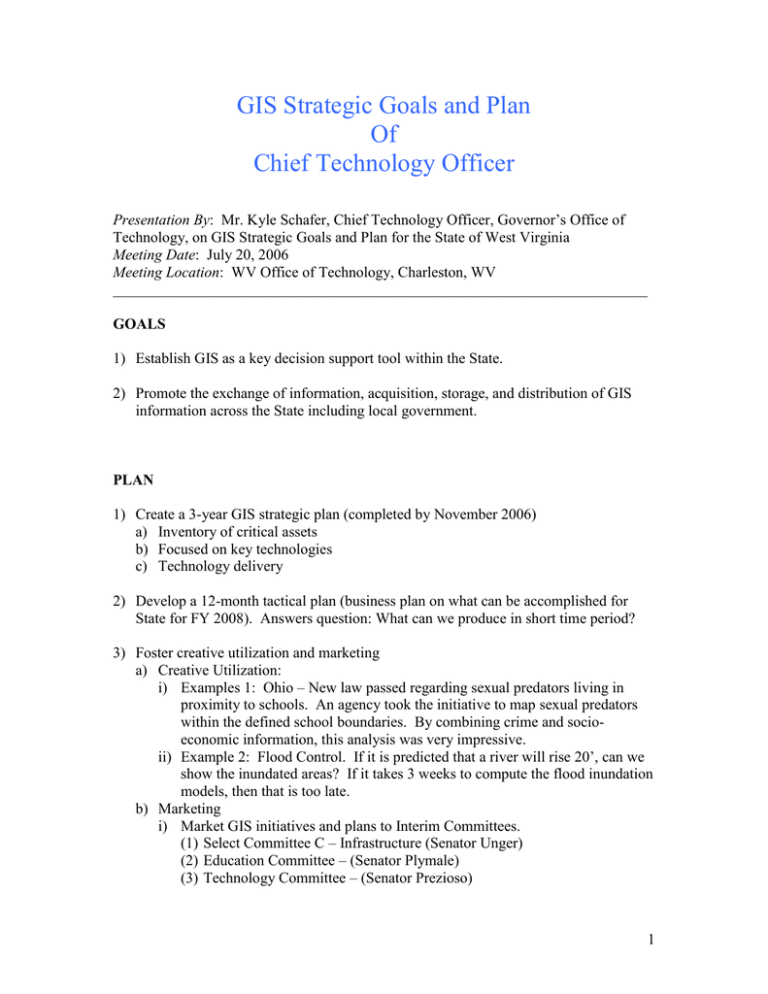GIS Strategic Goals and Plan Of Chief Technology Officer
advertisement

GIS Strategic Goals and Plan Of Chief Technology Officer Presentation By: Mr. Kyle Schafer, Chief Technology Officer, Governor’s Office of Technology, on GIS Strategic Goals and Plan for the State of West Virginia Meeting Date: July 20, 2006 Meeting Location: WV Office of Technology, Charleston, WV _______________________________________________________________________ GOALS 1) Establish GIS as a key decision support tool within the State. 2) Promote the exchange of information, acquisition, storage, and distribution of GIS information across the State including local government. PLAN 1) Create a 3-year GIS strategic plan (completed by November 2006) a) Inventory of critical assets b) Focused on key technologies c) Technology delivery 2) Develop a 12-month tactical plan (business plan on what can be accomplished for State for FY 2008). Answers question: What can we produce in short time period? 3) Foster creative utilization and marketing a) Creative Utilization: i) Examples 1: Ohio – New law passed regarding sexual predators living in proximity to schools. An agency took the initiative to map sexual predators within the defined school boundaries. By combining crime and socioeconomic information, this analysis was very impressive. ii) Example 2: Flood Control. If it is predicted that a river will rise 20’, can we show the inundated areas? If it takes 3 weeks to compute the flood inundation models, then that is too late. b) Marketing i) Market GIS initiatives and plans to Interim Committees. (1) Select Committee C – Infrastructure (Senator Unger) (2) Education Committee – (Senator Plymale) (3) Technology Committee – (Senator Prezioso) 1 ii) Publications targeting local and state government decision makers. (1) Benefits of GIS (2) Web-based GIS services available 4) Organizational Design a) Discourage organizational designs which lead to GIS “stovepipes” or “silos” b) Identify those accountable within an agency to provide GIS information. 5) Inventory of Information a) Inventory of critical assets (GIS data and services) i) Not looking at consolidation of all GIS services in State; however, would like to know what information exists. ii) Utility mapping – how is Kentucky mapping infrastructure? iii) Technology Improvement Initiatives - Senate Bill 653 (Expansion of broadband) or State Addressing and Mapping project. b) Gap analysis - where is gap in GIS services and data at the state level 6) Establish initial policies, procedures, and standards to promote interoperability and information sharing 7) Ongoing governance model PLAYERS 1) Commerce 2) DEP 3) DOT 4) Higher Ed 5) MAPS 6) PSC 7) Legislature 8) Federal Government 9) Local Government 10) Private Industry 2 ATTENDEE COMMENTS 1) Often counties and local governments don’t have the money or resources to implement GIS. 2) How can counties not afford to implement GIS? Counties should reorganize or update to GIS technologies to be more efficient. 3) Many legislative members don’t know GIS – need to put it in front of them. 4) Geospatial technologies exist to work at the enterprise level and not “stovepipe.” 5) On at least two occasions Mr. Schafer raised the point that he expects standards. He first mentioned standards in regard to "data" and the second reference related to an "enterprise" infrastructure discussion thread. As CTO he has established/is establishing numerous standards in conventional IT areas. 6) I think it is also important to note that Mr. Schafer very clearly stated that he is willing to work to facilitate appropriate legislation and willing to represent geospatial interests within the Executive Branch. Meeting notes compiled by Kurt Donaldson, WVGISTC, July 2006 3




